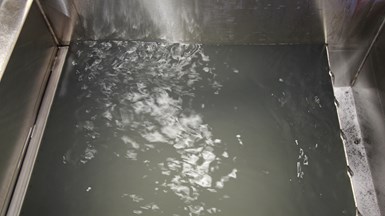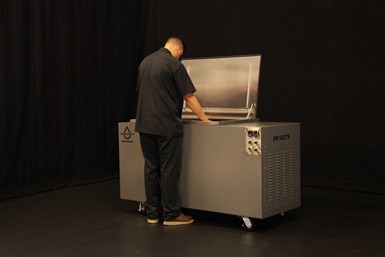Before there were computer-driven, front loading washing machines, there were washboards used to clean clothes by hand. Not only was it time consuming and difficult work, but the end result was usually only adequate. However, as with many other manual processes, technology came to the rescue and the problem was solved thanks to the birth of washing machines, computer chips and software programs.
Machined parts that have been soiled with cutting fluids, grease, metal shavings and other debris also require regular cleanups. And while this, too, can be accomplished by hand, the results are often the same as cleaning clothes with a wash board—only adequate. The fact is, grime and dirt must be thoroughly removed from all surfaces, threads and blind holes. Otherwise, plating, anodizing and coatings of all types simply will not adhere. Ultrasonic cleaners are for machined parts what washing machines are for cleaning clothes—a transformative solution that not only gets the job done faster and easier—but also more thoroughly.
The Technology Bubble
Ultrasonic cleaning uses ultrasonic waves, or sound that is far higher than the human ear can detect. Sound is created by waves, or vibrations in the air created by vibrating an object, which then causes the molecules surrounding it to vibrate. Our ears pick up these vibrations, translating them into sounds. The faster the vibrations, the higher the pitch of sound we hear. Ultrasound is created by waves, which resonate at higher than the upper human detection limit of 20 kHz (20,000 cycles or vibrations every second).

Ultrasonic cleaning machines use special transducers that are mounted to a diaphragm and then to the cleaning tank of a unit and immersed in water. The transducer vibrates rapidly, creating ultrasonic waves. This produces tiny “cavitation bubbles” clean parts well.
Ultrasonic cleaning machines use special transducers that are mounted to a diaphragm and then to the cleaning tank of a unit and immersed in water. The transducer vibrates rapidly, creating ultrasonic waves, usually between 20-kHz and 40-kHz, but sometimes as high as 1 MHz (known as megasonic technology). This produces tiny “cavitation bubbles,” bubbles that are so small that it would take 1,250 of them to measure a single centimeter. Each second, millions of these cavitation bubbles are generated. And, because they are so miniscule and gentle, they eliminate contaminants, such as dust, dirt, rust, oil, grease, soot, mold, carbon deposits, polishing compounds, wax, pigments, lime scale,

Small bubbles in an ultrasonic tank eliminate contaminants on a variety of parts and even debris embedded in tiny cracks and cervices.
bacteria, algae, fungus, fingerprints and biological soil. This process effectively cleans a variety of parts and equipment made from metals, plastics, glass, rubber and ceramics. It even removes debris embedded in tiny cracks and crevices.
First, users need to choose which ultrasonic machine design is best for their applications. The tabletop cleaner can be placed on a countertop or table and is designed for occasional and low-volume cleaning loads. For larger parts and loads, benchtop cleaners are the answer, as they are larger and generally stronger than tabletop cleaners. Floor models are intended for industrial cleaning, as are multi-stage systems, which use a wash tank, rinse area and drying chamber.

Finding the right ultrasonic machine design is critical to getting the best results. This floor model is intended for industrial cleaning and only washes parts.
When it comes to cost considerations, the individual, single-batch floor models are more costly than benchtop units. The price of floor models and multi-stage cleaning systems are fairly similar, however floor models only wash, whereby multi-stage cleaning systems integrate washing, rinsing and drying into a single system. Multi-stage systems are used when higher precision rinsing and drying are required

The multi-stage ultrasonic cleaning system integrates washing, rinsing and drying in a single system. These systems are used when higher precision ringing and drying are required and perform most effectively in the least amount of time.
and perform most effectively in the least amount of time—and the time saved directly translates to money saved.
Now that the machine design is chosen, other questions need to be asked prior to making a final decision about the machine purchase.
- What types of contaminants need to be removed—oils, light dirt, heavy dirt or dark dirt? If oils are being removed, a filtration system that skims from the top is needed. Heavier, excessive dirt that creates sludge at the bottom of the tank lends itself to bolt-on transducers so that the sludge doesn’t interfere with the ultrasonic performance. If you are removing dirt that suspends, you want the main bath to be filtered.
- What are the ultrasonic power requirements? Selecting enough power to clean within the time frames required is important. For most applications, 25-50 watts per gallon are sufficient.
- What frequency is needed? 40 kHz is the most common. This frequency creates a mid-range bubble that is small enough to penetrate most blind holes, yet strong enough to clean any application.
- What is the required process? This is key to having a positive outcome. Knowing the right chemistry, the right amount of cleaning time and the proper temperature is critical for success. Using the proper software is also critical for success.
Solving the Solution Dilemma
Ultrasonic cleaning solutions contain specially designed ingredients that increase the effectiveness of the process. However, one single detergent cannot remove every kind of contaminant. The type of part being cleaned also needs to be taken into consideration when selecting a solution because while removing the contaminant is necessary, the part must also be protected.
- General-Use Soap Solutions: With a high alkaline content, these solutions remove oil, grease and carbon deposits from metals and composites.
- Descalers: These acidic detergents remove corrosion, rust, hard mineral deposits and heat scale from metals and help restore parts that operate in hard water or high-humidity environments.
- Enzyme Detergents: Enzymes remove oil from stainless steel, aluminum, brass and titanium parts. They also remove biological contaminants from medical and dental tools.
- Low pH Cleaners: These citrical acid solutions clean and shine metals, but they can sometimes damage aluminum, copper and brass items.
- Specialty Detergents: Specialty solutions are designed to clean specific contaminants such as ink, resins or epoxies.
When choosing a solution for your ultrasonic cleaning application, one should consider the lifespan of the solution as well as how to dispose of it. Though ultrasonic cleaning baths are generally environmentally friendly and water-based, depending on the contaminants removed and solution used, various methods of waste disposal may be required.
Why Choose Ultrasonic Cleaning?
There are three main benefits manufacturers derive from using ultrasonic cleaning technology.
- Financial savings: Because these systems can clean more items in less time versus cleaning them manually, labor costs are reduced. Also, your investment in ultrasonic cleaning will pay off in the long run. According to the U.S. Environmental Protection Agency, the “payback period” generally ranges anywhere from as short as three months to less than five years.
- Health and welfare benefits for your employees: Manual cleaning can expose workers to harsh solvents, highly caustic chlorinated and fluoridated agents and hydrocarbons, which can pose health risks to those performing the cleaning. However, with ultrasonic cleaning systems, these non-toxic, aqueous-based detergents are completely safe for users.
- Environmentally friendly: This technology reduces the amount of hazardous waste put into the atmosphere because ultrasonic cleaning occurs in a contained tank environment. Plus, other forms of immersion cleaning use considerably more energy than ultrasonic cleaning, and less energy use means less pollution. Also, most ultrasonic cleaning detergents are approved by the EPA.
For machining manufacturers, ultrasonic cleaning units are an equivalent “game changer” in terms of the time, quality control and money saving benefits they offer. Cleaning things by hand, whether they are shirts or manufacturing components, has proven to be inefficient and ineffective thanks to the continual strides made in technology over the last several decades. It’s time to embrace a more precise, less time-consuming and more cost-effective way to clean parts by incorporating ultrasonic cleaning into all cleaning operations.
Omegasonics | 800-669-8227 |omegasonics.com
About the Author
Frank Pedeflous
Frank Pedeflous is the president of Omegasonics, a California-based manufacturer of ultrasonic cleaning systems. For more information on Omegasonics and ultrasonic cleaning technology, visit omegasonics.com.
Learn More
For more information about ultrasonic cleaning, read “Ultrasonic Cleaning for Large Lots of Small Parts.”
Also see our Parts Cleaning Equipment Zone for more information.
Related Content
3 Common Filtration Questions Answered
Learn about the variety of filters for removing particulates from a cleaning fluid, how to determine cleaning fluid life and more.
Read MoreOvercoming 3 Common Challenges With Automated Particle Counting
Facing difficulties while performing particle analysis is normal but should not be discouraging. Here are some ways to handle the most prevalent issues that can arise.
Read MoreIndustrial Cleaning Shop Zeros In on Precision
This parts cleaning company is elevating its efforts to become a technical cleanliness expert, which presents an exciting, yet sometimes arduous, journey. The ongoing education of the team as well as significant investments in equipment and processes attribute to this shop’s success.
Read MoreSita’s CleanoSpector Measures Part Cleanliness
PMTS 2023: Handheld measuring device checks for cleanliness of parts to assure product quality as well as prior to follow-up processes.
Read MoreRead Next
Collateral Benefits of Ultrasonic Cleaning
A manufacturer of traffic and crosswalk signals strives for part durability and consistency throughout its operations.
Read MoreA Refresher Course on Ultrasonic Cleaning
A close look at the intricacies of this technology helps with understanding how it is most effectively applied.
Read More6 Things to Know about Ultrasonic Cleaning
I revisit an ultrasonic cleaning article to explain six main ideas that jumped out at me as points for shops to remember when selecting ultrasonic equipment.
Read More















.jpg;maxWidth=300;quality=90)







